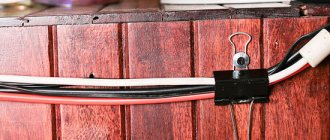Sometimes the closet resembles a basket of assorted laundry. It is not clear what is where, there is only enough order for a couple of days. In search of the right thing, everything turns upside down again. Lack of space makes the situation worse. I would like to carry out an audit and empty a couple of shelves. Believe me, this will not save you.
There is a road to ideal order - you need to fold your bed linen compactly and reconsider your organization principles. Let's look at the most convenient methods used by housewives all over the world.
Vertical (Japanese)
There is a second name - the Konmari method. In Japan, apartments are small. The living space is not furnished with bulky cabinets and walls. Therefore, housewives actively use vertical storage in drawers of chests of drawers. Or they fill out the organizers and then put them away in the dressing rooms.
Storing bed linen using the Konmari method
Instructions:
- Fold the duvet cover 4 times and smooth it out with your hands.
- Fold the edges of the package toward the center to create a strip the width of the organizer.
- Fold the ends of the fabric bundle again towards the center, on top of each other. Now we focus on the height of the box.
- Roll all items using the described technology into a square or rectangle. Place in the box vertically with the fold up. Place the bundles tightly so that they retain their shape.
If you are going to use the chest of drawers for vertical storage, then bedding should be folded into a rectangle, not a square. Consider the height and width of the drawer to ensure the stacks fit and look neat.
A special feature is that all the items in the set can be stored in different places in the drawers. For small packages, strong boxes and plastic containers are suitable.
Chests of drawers with small drawers are not suitable for the Japanese method; the depth should be more than 25 cm.
Is it possible to store bed linen neatly?
Not really
Cleaning the house using Konmari
This concept appears in many sources. But still, this method does not apply to cleaning in its classical sense.
Cleaning is the process of getting rid of trash and dirt. Moreover, it is regular, requiring attention every day.
Photo: Instagram aline.designburo
Konmari doesn't talk about dusting or washing dishes. She offers a new philosophy of life. And he even announces that by reorganizing your life, you can radically change your thinking, occupation, attitude towards the past and attitude towards the future.
Marie is convinced that everything we do is necessary for happiness. Traveling abroad, buying delicious food, watching an evening movie in front of the TV. And when we do cleaning, our ultimate goal is also to get closer to a state of happiness.
The chain can be built like this: I clean so that the house is beautiful (so that the necessary things can be quickly found/so that I am not ashamed in front of guests/so that my mother does not scold), which means I increase the level of my own internal comfort.
Photo: Instagram lena__giesbrecht
By providing yourself with the most comfortable conditions, a person becomes happier.
Classical
Soviet people were accustomed to storing clean bed linen in piles in the closet. This method has more disadvantages than advantages. There are voids at the top, and this is a precious place. Getting the right thing carefully is a real quest. There are a lot of creases left on the lower objects. They are difficult to straighten. If you are a fan of perfectly smooth linen, you will need to iron again.
Instructions:
- Fold ironed laundry into squares and rectangles.
- Place in stacks according to the size of the shelves.
- It is important to turn the bundles with the fold point facing outwards.
- Place stacks of laundry on shelves.
It’s good if the shelf allows you to place several stacks of different sizes side by side. If not, there may be a mess. It can be difficult to carefully get a certain item, especially in a hurry. You can make additional shelves from plywood with your own hands; they compensate for the height of the stacks.
Folding bedding and clothes compactly in the classic way will not work. To save space, it is recommended to use the Japanese roll method with a pillowcase.
Decluttering by Konmari
When you have taken out all the things of a certain category and put them into groups, the author of the system suggests taking each thing in your hands and “testing” it to see what emotions it evokes in you. Even if the item is of high quality and, by definition, “should be” in your wardrobe as a basic item, but you are not ready to wear it, get rid of it.
Photo: Instagram mariekondo
Good clothes don't have to be thrown away. It can be given as a gift, but this moment also requires great awareness.
Marie Kondo advises to “thank” any thing that is no longer needed for its service. The writer, not without reason, believes: if you bought an ugly jacket, then it had its own mission in your life. Perhaps it boiled down to teaching you how to choose your wardrobe more competently.
Photo: Instagram mariekondo
Photo: Instagram mariekondo
Marie advises starting with seasonal clothing. And this also makes sense: by refreshing your memory of what exactly you have in stock, you will not buy too much in the run-up to winter or summer. In general, in her opinion, you should not put away either warm or light things.
Photo: Instagram mariekondo
In the summer you may need a sweater, and in the winter you can wear a light dress under a warm coat in not very frosty weather.
Although for residents of those regions where the temperature difference is too large, such advice is unlikely to be suitable. After all, you certainly won’t need a fur coat in the hot summer, even on cool evenings.
When decluttering, we very often reclassify household items that are not suitable for going out in public. Marie thinks this approach is wrong. The way a person looks at home affects his mood and the perception of his family members no less than an elegant look.
Photo: Instagram mariekondo
A mountain of household items, some of which will not be worn, is also trash. And it needs to be trashed regularly.
Set in pillowcase
There is no need to look for components from one set, take out all the things, and put things in order again. The linen looks neat, compact, and it’s easy to visually estimate its quantity. Convenient in homes with a large number of bedding sets.
Instructions:
- Fold the ironed duvet cover into a rectangle. The size is approximately half the size of a pillowcase.
- Do the same with the rest of the laundry.
- Make a pile, press it, place it in a pillowcase.
- Fold in the free edge of the pillowcase. If there is a pocket, then it can be used for its intended purpose. The result is a compact rectangular package.
- Put away for storage.
Method of folding bed linen into a pillowcase
Pros:
- order in the closet;
- everything is in one package, nothing is lost;
- neat appearance, looks neat;
- compact storage.
Minuses:
- stacks from different sets differ in thickness;
- creases are possible;
- Suitable for sets only.
- Suitable for deep cabinets.
Bundles are placed in storage areas both vertically and horizontally. In the latter case, it is recommended to periodically take the laundry from the bottom of the pile and change places. Otherwise the kit will cake.
Lifespan of bed linen
Sleeping sets are made from a variety of materials: polyester, lavsan, bamboo fiber, Tencel, viscose. The composition of the fabric determines the density of the structure and the performance qualities of the textile.
The service life of linen made from different fabrics is as follows:
- The service life of loose flannel sets is 5 years;
- calico bed linen lasts an average of 6–7 years;
- sets made of fabric of sufficient density are used for 8–9 years (linen, cotton);
- linen made of artificial silk and satin retains its original appearance for up to 10 years;
- natural silk sheets - 10–15 years.
With proper care, textiles retain their neat appearance longer. Careful use ensures better hygienic properties and a long service life.
In your pocket
Convenient method of storing kits. Use step-by-step instructions in pictures:
- Spread the duvet cover, fold it 4 times, smooth out any unevenness or creases.
- Fold the sheet on top, folded 6-8 times, depending on the size.
- Next are the pillowcases. Smooth out with your hands.
- Fold the left edge to the center by a third of the width.
- Fold the right side over the left. You will get a long strip.
- Fold the left side of the fabric strip 2/5 towards the center. A piece equal to 1/5 of the entire length should be visible from underneath it.
- Spread the resulting pocket, insert the free edge of the right side.
- It should be a rectangle or square, depending on the size of the bed linen. Place the folded set on a shelf or in an organizer.
Folding bed linen using the “pocket” method
Advantages:
- An even, compact package that retains its shape.
- The edges do not puff up, do not come out, and are easy to take out.
Minus:
- Need training. Folding is difficult the first time, but once you master the technique, the process will not take much time.
Using any option for folding bed linen, you can forget about ironing. Careful smoothing with your hands replaces ironing.
How to properly organize their storage
- Determine your end goal. How exactly do you imagine your home? Look at pictures of interior design on the Internet and choose the ones you like. Recreate your future home (from the inside) in your head and, possibly, on paper.
- Clean out the space as much as possible. Leave only what is most pleasant and dear to you (and what you absolutely cannot do without). Once you experience the convenience of “minimalism,” you won’t want to go back to “littering.”
- Don't let your relatives peek or interfere! All the “experts” with advice on the topic - “leave it”, “this is an expensive thing, you’re crazy” and “there’s a lot of space on the mezzanine, let’s put it there, it will come in handy later!” - drive away!
- Let's sort things by category! We don’t clean the closet or hallway, but books or cosmetics. We collected all the books in one place, sorted them into “causes joy” and “throw away”, took out the 2nd pile, and put the 1st pile beautifully in one place.
- Cloth. We don’t make home “outfits” out of tired clothes! Either throw it away or give it to good hands. Even if no one sees you, you should walk in what brings you joy. And these are unlikely to be tattered “sweatpants” with a faded top.
- How to fold? We fold clothes in piles, but vertically! That is, when you look into the drawer, you should see all your blouses, and not just the top one. This makes it easier to find the item (no need to dig through the entire stack), and order is maintained.
- Put everything that you do not wear this season on the far shelves (umbrellas, jackets, swimsuits, gloves, etc., depending on the season).
- Documentation. Everything is simple here. 1st pile: documents that are needed. 2nd pile: documents that need to be sorted out. For the 2nd pile, take a special box and put all questionable papers there and only there. Don't let them crawl around the apartment.
- Do not store pieces of paper, postcards, or documents that have no value. For example, instructions from household appliances that you have been using for more than a year (unless it is a warranty card), paid rent receipts (if 3 years have passed since payment), papers on loans paid off long ago, instructions for medications, etc.
- Postcards. It’s one thing if it’s a memorabilia that gives you a wild rush of joy and nostalgia at the same time, it’s another thing when it’s a box of duty postcards. Who needs them? Say goodbye to such things with confidence!
- Coins. Don’t scatter “change” around the house, pouring it on the refrigerator, then on the coffee table, or in a piggy bank that you will never open, because it “is no longer money.” Spend it right away! Place it in your wallet and use it on small items in stores.
- Present. Yes, it would be a shame to throw it away. Yes, the man was on duty trying to congratulate you. Yes, it's somehow inconvenient. But you still won’t use this coffee grinder (handle, figurine, vase, candlestick). Get rid of it! Or give it to someone who will enjoy this gift. What to do with unnecessary gifts?
- Equipment boxes. What if it comes in handy? - we think and put another empty box in the closet, without putting anything in it. If only those unnecessary buttons, 100 instructions for medications that you never look at (because there is the Internet) or 20 extra mercury thermometers. Throw it away immediately!
- There in the trash - all the things whose purpose you have no idea at all, or simply never use at all. Some strange cord, an ancient non-working TV, microcircuits, an old tape recorder and a bag of cassettes, cosmetics samples, things with the logo of your university, trinkets won in the lottery, etc.
- Photos. Feel free to throw out all the pictures that do not evoke emotions in you. We leave only those dear to our hearts. Why do you need thousands of faceless landscapes if you can’t even remember when, why and who photographed it? This advice also applies to photo folders on your PC.
- Bags. If you use them, store them inside each other so that they take up less space. Cracked, faded, out of fashion - throw away. And be sure to empty out your everyday bag every day so as not to turn it into a warehouse of strange things.
- Every thing has its own place! And all things of the same type - in one place. One closet contains clothes. In the nightstand - things for sewing. On the upper shelves are documents. And don’t even think about mixing them with each other. A thing without a place is a new way to the old disorder.
- Bathroom. We do not litter the edges of the bathtub and sink. We put all the bottles with gels and shampoos in the nightstand and cabinets.
According to Marie, clutter comes from the fact that we do not know how to return things to their rightful places. Or because it takes too much effort to return them to their places. Therefore, decide on the “places”!
On a roll
This is the standard method for folding laundry sets. Instructions:
- Unfold the duvet cover, fold the sides inward several times until you get a long strip.
- Fold the other items in the set in the same way.
- Place pillowcases on the duvet cover, then the sheet.
- Roll into a roll.
- Place an organizer on a shelf, in a drawer.
Method of folding bed linen into a roll
Plus:
- No creases.
- The roll can be folded compactly into any closet, chest of drawers, drawers, containers, or fabric organizer.
Minus:
- You need to sort your laundry by size.
- For sets with different configurations, the rolls differ in size.
This method is not suitable for fitted sheets. But rolls can be stored vertically or horizontally. It is not necessary to roll the entire set together; sometimes this is done separately with each copy of the set.
You can fold towels, jeans, and other items of clothing into compact rolls. The method is suitable for assembling a suitcase for a trip.
Envelope
The advantages of this method are the absence of creases, everything is stored in one place, and ease of folding. The downside is the lack of compactness. Double sets make impressive envelopes. Suitable for storing linen in a wardrobe, on a rack in a dressing room.
Instructions:
- Fold the sheet in half, then 2 more times. Check for evenness.
- Place in the center of the flattened duvet cover.
- Spread one or two pillowcases on top.
- Fold the duvet cover from the top and bottom to the middle. Check strip width and align.
- Fold the sides towards the center. You will get an envelope.
- The laundry is folded! Can be put in the closet.
When folding double sets of linen, you do not need to follow the instructions exactly; difficulties and unevenness may arise. It is recommended to fold the euro sheet 6 or 8 times, otherwise you will end up with a large envelope.











